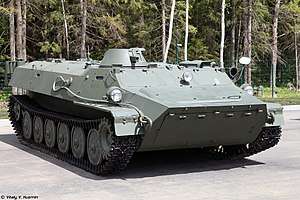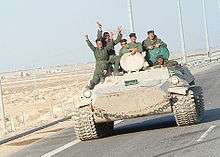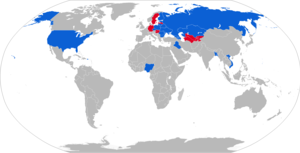MT-LB
The MT-LB (Russian: Многоцелевой Тягач Легкий Бронированный, Mnogotselevoy Tyagach Legky Bronirovanny / Multi-Purpose Towing Vehicle Light Armoured) is a Soviet multi-purpose fully amphibious auxiliary armored tracked vehicle, which was first introduced in the 1950s. It is also produced in Poland, where (starting mid-1990s) its YaMZ engine was replaced by a Polish one.[1]
| MT-LB | |
|---|---|
 MT-LB | |
| Type | Armored personnel carrier Infantry fighting vehicle |
| Place of origin | Soviet Union |
| Service history | |
| In service | late 1950s – present |
| Used by | See Operators |
| Production history | |
| Designer | Central Auto and Tractor Directorate |
| Designed | 1950s |
| Manufacturer | Kharkiv Tractor Plant |
| Specifications | |
| Mass | 11.9 tonnes (13.1 short tons; 11.7 long tons) |
| Length | 6.45 m (21 ft 2 in) |
| Width | 2.86 m (9 ft 5 in) |
| Height | 1.86 m (6 ft 1 in) |
| Crew | 2 (+ 11 passengers) |
| Armor | 14 mm max. |
Main armament | 7.62 mm PKT machine-gun (2,500 rounds) or 12.7mm NSV or Kord machine gun or 30mm autocannon (2A42 or 2A72) |
Secondary armament | AGS-17D or AGS-30 grenade launcher |
| Engine | YaMZ 238, V-8 diesel 240 hp at 2,100 rpm |
| Power/weight | 20 hp/tonne |
| Suspension | Torsion bar |
Operational range | 500 km (310 mi) (road) |
| Maximum speed | 61 km/h (38 mph) (road) 30 km/h (19 mph) (off-road) 5 to 6 km/h (3.7 MPH) (in the water) |
Development
In the 1950s, the Soviet Central Auto and Tractor Directorate began a development program to replace the AT-P series of artillery tractors (which were based on the ASU-57 airborne self-propelled gun) with a new generation of vehicles. The MT-L was developed to meet this requirement based on the PT-76 amphibious light tank chassis. The MT-LB is the armored variant of the MT-L. Entering production in the early 1970s, it was cheap to build, being based on many existing components, e.g. the engine, which was originally developed for trucks. It is built at the Kharkiv Tractor Plant[2] and under license in Poland by Huta Stalowa Wola[3] and Bulgaria.
Description
The crew, a driver and a commander/gunner sit in a compartment at the front of the vehicle, with the engine behind them. A compartment at the rear enables up to 11 infantry to be carried or a cargo of up to 2,000 kg. A load of 6,500 kg can be towed. The vehicle is fully amphibious, being propelled by its tracks in the water.
A small turret at the front of the vehicle fits a 7.62 mm PKT machine gun with 360-degree manual traverse and an elevation of −5 to +30 degrees. The vehicle is lightly armored against small arms and shell splinters with a thickness of 3 to 10 mm of steel with a maximum of 14 mm for the turret front.[4] The infantry compartment has two hatches over the top, which open forwards. There are four firing ports—one on either side of the hull, the other two in the rear twin doors of the infantry compartment.
The driver is provided with a TVN-2 infra-red periscope, which in combination with the OU-3GK infra-red/white light searchlight provides a range of about 40 m. All vehicles include an NBC system.
Variants
Former USSR

- MT-L
- MT-LB (izdeliye 6) – basic model, often used as simple APC but also as artillery tractor or ambulance. In the West the term MT-LB Blade or MT-LB M1980 is used for vehicles that are fitted with a hydraulic dozer blade.
- MT-LBV (vezdekhodny) – low-pressure track version, with 565 mm (22-inch) tracks giving a ground pressure of 0.27 kgf/cm² (26 kPa). Used in Arctic regions instead of BMP or BTR wheeled vehicles.
- MT-LBVM – with NSVT 12.7 mm instead of the original 7.62 mm machine gun turret.
- MT-LBV-N
- MT-LBV-NS
- MTP-LB – technical support version with no turret, an A-frame and stowage on the roof.
- SNAR-10 "Jaguar" (stantsiya nazemnoy artilleriskoy razvedki) – with 1RL-127 ("BIG FRED") Ground surveillance radar in a large rotating turret. Range: 16 km. Old NATO designators are MT-LB M1975 and MT-LB SON.
- SNAR-10M "Pantera" – upgraded, automated system with a range of 40 km.
- 9A34 – launch vehicle of the 9K35 "Strela-10" (SA-13 Gopher) system.
- 9A35 – as per 9A34 but additionally with a passive detection system.
- 9P149 "Shturm-S" – anti-tank version with a retractable launcher for 9M114 Kokon ATGM. The vehicle carries 12 missiles on board and entered service in 1979. It has a crew of 2.
- RKhM "Kashalot" (razvedivatel'naya khimicheskaya mashina) – chemical reconnaissance vehicle with detection, marking and alarm devices. This model has the hull shape and single rear door of the 2S1. Former Western designator: ATV M1979/4.
- RKhM-K – command version with additional signal equipment but without sensors or markers.
- RPM (radiatsionno-poiskovaya mashina) – radiological reconnaissance vehicle with a single KZO-2 flag dispenser and equipped with radiation detection devices NGP-81 (gamma), KDN-2 (neutrons), KRB-1 (beta), KRA-1 (alpha).
- K-611 – radiological reconnaissance vehicle.
- K-612 – radiological reconnaissance vehicle.
- AZM "Vostorg-1" (aviatransportabel'naya zemleroynaya mashina) – engineer vehicle, equipped with a hydraulic dozer blade and an extendable hydraulic arm with a bucket.
- MT-LBV (vezdekhodny) – low-pressure track version, with 565 mm (22-inch) tracks giving a ground pressure of 0.27 kgf/cm² (26 kPa). Used in Arctic regions instead of BMP or BTR wheeled vehicles.
- MT-LBu – variant with a larger hull and longer chassis. Many so-called "MT-LB variants" are in fact based on the MT-LBu.
- UR-77 "Meteorit" – mine-clearing system with a rocket-launched explosive hose.
- 2S1 122 mm self-propelled howitzer.
- MT-LB (izdeliye 6) – basic model, often used as simple APC but also as artillery tractor or ambulance. In the West the term MT-LB Blade or MT-LB M1980 is used for vehicles that are fitted with a hydraulic dozer blade.
Russian Federation
- MT-LBM (izdeliye 6M) – MT-LB modernization developed by Muromteplovoz in the 1990s. It can be fitted with several different turrets.
- MT-LBM (izdeliye 6MA) – MT-LBM fitted with a turret from BTR-80, with a KPVT 14.5mm machine gun and co-axial PKT 7.62mm machine gun.
- MT-LBM (izdeliye 6MA1) – MA armed with additional AGS-17 30 mm automatic grenade launcher.
- MT-LBM (izdeliye 6MA4) – MA1 armed with KPVB 23x115 mm instead of KPVT 14.5 mm heavy machine gun.
- MT-LBM (izdeliye 6MA2) – MA armed with KPVB 23x115 mm instead of KPVT 14.5 mm heavy machine gun.
- MT-LBM (izdeliye 6MA1) – MA armed with additional AGS-17 30 mm automatic grenade launcher.
- MT-LBM (izdeliye 6MA3) – MT-LBM armed with four 9M133 Kornet ATGM launchers, 7.62 mm PKTM tank machine gun and an AGS-30 30 mm automatic grenade launcher.
- MT-LBM (izdeliye 6 MB) – MT-LBM fitted with a turret from BTR-80A, using a 2A72 30 mm autocannon and co-axial PKT 7.62mm machine gun.
- MT-LBM (izdeliye 6MB2) – MB armed with AGS-17 30 mm.
- MT-LBM (izdeliye 6MB3) – MT-LBM armed with GSh-23V 23 mm, AGS-30 30 mm and "Kord" 12.7 mm.
- MT-LBM (izdeliye 6MB4) – MT-LBM armed with GSh-30K 30 mm, AGS-30 30 mm and "Kord" 12.7 mm.
- MT-LBM (izdeliye 6MB5) – MT-LBM armed with twin gun 23 or 30 mm, "Igla" SAM and equipped with improved sights.
- MT-LBM1 (izdeliye 6M1) – MT-LBM fitted with 300–310 hp engine.
- MT-LBM2 – MT-LBM upgrade package developed by Kurganmashzavod with new engine and transmission, improved suspension, BMP style side skirts etc. Prototype.
- MT-LBM (izdeliye 6MA) – MT-LBM fitted with a turret from BTR-80, with a KPVT 14.5mm machine gun and co-axial PKT 7.62mm machine gun.
- 2S24 – mortar carrier with 2B24 (or 2B14 "Podnos") 82 mm mortar and 83 rounds. The system designator for the carrier vehicle, mortar, and ammunition is 2K32 "Deva". The 2S24 was designed by TsNII "Burevestnik" and has a crew of five. In service with RF Interior Ministry.[5][6]
- MT-LBVMK – a modification of MT-LBVM with "Kord" 12.7 mm machine gun instead of NSVT 12.7 mm.[7]
- Toros – Arctic adapted vehicle developed by Muromteplovoz based on the MT-LB chassis armed with a 30mm autocannon 2A42, PKMT 7.62mm machine gun, and 30mm AGS-17D grenade launcher, and equipped with a snowplow. Toros is able to operate in −45 °C.[8][9]
Bulgaria
- MT-LB AT-I – tractor for mine-laying systems. Fitted with racks for anti-tank mines.
- MT-LB RHR or MR HR (mashina za radiatsionno i khimichesko razuznavane) – NBC reconnaissance vehicle with detection, alarming, sampling and markings devices.
- MT-LB SE – ambulance.
- SMM B1.10 "Tundzha" (samokhodna minokhv'rgachka) – mortar platform with M-38/43 120 mm mortar and 58 rounds.
- SMM 74 B1.10 "Tundzha-Sani" – improved version with 2B11 120 mm mortar.
- KShM-R-81 "Delfin" – command and staff vehicle with R-123M, R-130M and R-31M radios, an AZI frame antenna, a generator and an additional cupola on the hull roof.
- MT-LB TMX – mortar carrier with 82 mm mortar M-37M.
- BRM "Sova" (bronirana razuznavatelna mashina) – reconnaissance version with NBC detection system ASP-3 and VPHR, radio sets R-123M and R-31M, PAB-2 aiming circle and NSPU night vision device. Comes in three versions with additional specialized equipment:
- "Sova-1" – with R-130M radio set, an AZI frame antenna, and a telescopic mast.
- "Sova-2" – with R-143 "Lira" radioset.
- "Sova-3" – with PSNR-5K (1RL-133) battlefield surveillance radar.
- R-80 – artillery forward observer vehicle with observation devices.
- BMP-23 (bojna mashina na pekhotata) – infantry fighting vehicle with 23 mm gun 2A14 and ATGM 9K11 "Malyutka" in a 2-man turret. The chassis is based on the one from the MT-LB but with components of the 2S1 and fitted with a 315 hp engine.
- BMP-23D – improved version with 9K111 "Fagot" and smoke grenade launchers.
- BRM-23 – reconnaissance version. Prototype.
- BMP-30 – similar chassis as the BMP-23 but with the complete turret of the Soviet-made BMP-2. Only 10 built.

East Germany
- MT-LB (Pi) – combat engineer vehicle.[10]
- MT-LB (Pzj) – version for anti-tank units.
- MT-LB (Pzj Fü) – command vehicle for anti-tank units.
- MT-LB (BO) SFL – battery command vehicle in self-propelled artillery units.
- SaN MT-LB – ambulance
- MTP-LB – technical support vehicle.
Iraq

- MT-LBV fitted with wider tracks.
- MT-LB converted into a SPAAG by mounting a ZU-23-2 23 mm twin anti-aircraft gun on the rear part of the vehicle. The gun had its wheels removed and as such cannot be easily dismounted and used separately. There were at least two variations of this conversion; one with the ZU-23-2 mounted in an open-topped turret, the other with the ZU-23-2 mounted on a platform extending beyond the hull of the MT-LB with a roof for the gun operators. The second version was most likely intended to be used in a fire support role, as the roof would hinder the gun's sights at high elevation.[11]
Poland
Polish HSW S.A. (Huta Stalowa Wola S.A.) license produced MT-LB since 1976, and it also developed a modified chassis SPG-2, with better floating capabilities.[12]
- MT-LB-2AP – APC variant with a turret from SKOT-2AP, armed with high elevation 14.5mm KPVT MG and 7.62mm PKT CMG. Prototype only.
- WEM Lotos – medical evacuation vehicle with four stretchers.
- WPT Mors – armored recovery and repair vehicle, produced from 1983.
- R-137T (radiostacja ruchoma UKF) – signals vehicle with VHF radio set R-137. Entered service in 1987 and has a range of 70 to 150 km.
- ZWD-1 "Irys" (zautomatyzowany wóz dowodzenia) – command vehicle, belongs to the automated command set "Irys".
- MT-LB-23M "Krak" – APC variant with a 23 mm gun in an unmanned turret. Prototype only.
- Promet – self-propelled AA gun with twin 23 mm guns, from 1979. Four prototypes only.
- "Przebiśnieg" – electronic warfare system, consists of three different vehicles:
- SZ or MT-LB Z (stacja zakłóceń) – EW/Jamming vehicle;
- SR or MT-LB R (stacja rozpoznania) – Comint/Sigint vehicle;
- WD krel – command post vehicle (wóz dowodzenia kompanii radioelektronicznej).
- SPG-2 – much-modified base vehicle, with reworked nose section and hydro jets for better floating:[12]
- TRI Hors – engineering reconnaissance vehicle, built in series from 1983, armed with 12.7mm NSVT AAMG mounted on a turret;[12]
- WPT Mors-II – armored recovery and repair vehicle, produced from 1986, armed with 12.7mm NSVT AAMG mounted on a turret;[12]
- Opal-I and Opal-II – artillery command vehicles, with a turret with NSWT-12.7 Utios: Opal-I with a 245 hp (180 kW) turbocharged diesel engine SW680/167/1, Opal-II with a 300 hp (220 kW) engine SW680T (YaMZ-238N) and a longer chassis with 7 road wheels on each side.[13] Prototypes only.
- BWO-40 – infantry fighting vehicle with 40 mm Bofors gun. A similar turret was mounted on the BWP-40 (BMP-1 upgrade). Prototype only.
Sweden

- Pbv 401 (pansarbandvagn) – modified former East-German vehicle with 7.62 mm machine guns Ksp 95 and Ksp 58.
- Stripbv 4011 (stridsledningbandvagn) – battalion-level command post.
- Bgbv 4012 (bärgningsbandvagn) – Swedish designator for the MTP-LB.
- Rlpbv 4014/T (radiolänkbandvagn) – signals vehicle.
- Stripbv 4021 (stridsledningbandvagn) – company-level command post.
- Sjvpbv 4024 (sjukvårdspansarbandvagn) – Military ambulance.
- Lvrbpbv 4016 (luftvärnsrobotbandvagn, "anti-air missile tracked wagon") – an unconfirmed designator for vehicles, equipped with RBS 70.
- Pvrbbv 452 (pansarvärnrobotbandvagn) – with RBS 56 BILL 1 Anti-tank guided weapon.
List of conflicts
- 1979–1989: Soviet–Afghan War (Soviet Union)
- 1980–1988: Iran–Iraq War (Iraq)
- 1991: Gulf War (Iraq)
- 1991: 1991 uprisings in Iraq (Iraq)
- 1992: Nagorno-Karabakh War (Armenia, Azerbaijan)
- 1992: Transnistria War
- 1994–1996: First Chechen War (Russia, Chechnya)
- 1999–2009: Second Chechen War (Russia)
- 2003: Invasion of Iraq (Iraq)
- 2003–2010: Iraq War (Iraq)
- 2008: 2008 South Ossetian War (Russia, Georgia)
- 2009: Boko Haram insurgency (Nigeria)
- 2011–2019: Syrian Civil War (Pro-government militias)[14]
- 2014: War in Donbass (Ukraine, Pro-Russian Separatist Forces)
- 2014: Iraqi Civil War (Iraqi Government forces, ISIS)[15][16]
Operators

Current operators
.jpg)





















Former operators







.svg.png)
Surviving vehicles
- Museum of Missouri Military History, on static display outside the museum
Notes
- "MT-LB multipurpose tracked armoured vehicle technical data sheet specifications pictures video". Archived from the original on 3 November 2018.
- http://tractor-xtz.com/tractor/htz-3n-snegobolotohod/HTZ-3H-road vehicles Archived 2 March 2014 at the Wayback Machine
- http://hsw.pl/czytaj/765 Archived 11 November 2014 at the Wayback Machine Light Armoured Multipurpose Tracked Tractor MTLB
- "MT-LB Light Armored Multi-purpose Vehicle". www.inetres.com. Gary's Combat Vehicle Reference Guide. Archived from the original on 7 October 2018. Retrieved 22 August 2018.
- "JSC CRI "Burevestnik"/ 82 mm 2K32 MORTAR SYSTEM". Burevestnik.com. Archived from the original on 18 April 2011. Retrieved 22 March 2013.
- "Archived copy". Archived from the original on 29 May 2018. Retrieved 28 May 2018.CS1 maint: archived copy as title (link)
- Транспортер-тягач МТ-ЛБ ВМК (in Russian). Muromteplovoz. Archived from the original on 6 February 2015. Retrieved 6 February 2015.
- "Russia could order Toros tracked armoured vehicle for military units deployed in the Arctic Region 11805162 | weapons defence industry military technology UK | analysis focus army defence military industry army". Archived from the original on 3 November 2018.
- "Tłumacz Google".
- Gau L-R., Plate J., Siegert J. (2001) Deutsche Militärfahrzeuge – Bundeswehr und NVA. Motorbuch Verlag. ISBN 3-613-02152-8
- Jim Webster. "MT-LB [ZU-23 – Iraq] tracked armoured fire support vehicle". Jedsite.info. Retrieved 22 March 2013.
- Jerzy Kajetanowicz, Prace nad rozwojem sprzętu pancernego w Polsce – przegląd lat 1955–1990 in: Poligon nr.5/2010, pp.12–18 (in Polish)
- "Lekki samobieżny zestaw przeciwlotniczy Sopel/Stalagmit" (in Polish). Militarium. Archived from the original on 9 February 2012. Retrieved 5 October 2016.CS1 maint: BOT: original-url status unknown (link)
- Puxton, Matteo (25 February 2019). Macé, Maxime (ed.). "Pour se battre en Syrie, l'Iran enrôle massivement des Afghans chiites". France Soir (in French). Archived from the original on 27 February 2019. Retrieved 27 February 2019.
- Puxton, Matteo (30 August 2017). "Kataib al-Imam Ali, cette puissante milice chiite qui se bat à la fois en Irak et en Syrie". France Soir (in French). Archived from the original on 4 April 2019. Retrieved 27 February 2019.
- "Etat islamique et chars d'assaut: comment les djihadistes emploient leurs blindés en Irak et en Syrie". France Soir (in French). 2 February 2017. Archived from the original on 3 February 2017. Retrieved 27 February 2019.
- The Military Balance 2017, p. 199.
- The Military Balance 2017, p. 201.
- The Military Balance 2017, p. 495.
- The Military Balance 2017, p. 274.
- The Military Balance 2017, p. 97.
- The Military Balance 2017, p. 203.
- The Military Balance 2017, p. 508.
- The Military Balance 2017, p. 511.
- The Military Balance 2017, p. 109.
- The Military Balance 2017, p. 205.
- The Military Balance 2017, p. 380.
- The Military Balance 2017, p. 206.
- The Military Balance 2017, p. 133.
- The Military Balance 2017, p. 209.
- The Military Balance 2017, p. 316.
- The Military Balance 2017, p. 528.
- The Military Balance 2017, p. 136.
- The Military Balance 2017, p. 145.
- The Military Balance 2017, p. 212.
- "Archived copy". Archived from the original on 16 May 2018. Retrieved 16 May 2018.CS1 maint: archived copy as title (link)
- "Archived copy". Archived from the original on 28 April 2019. Retrieved 28 April 2019.CS1 maint: archived copy as title (link)
- The Military Balance 2017, p. 228.
- John Pike. "Ground Forces Equipment – Ukraine". Globalsecurity.org. Archived from the original on 7 July 2017. Retrieved 22 March 2013.
- https://www.rp.pl/Przemysl-Obronny/310139972-Drgnelo-w-eksporcie-broni.html
- The Military Balance 2017, p. 472.
- http://scout.com/military/warrior/Article/Russia-Built-Armored-Vehicle-Like-US-M113-101459350
- "Puolustusvoimat hankkii miehistönkuljetusajoneuvoja". The Finnish Defence Forces. 24 March 2011. Archived from the original on 10 May 2012. Retrieved 24 March 2011.
- Kočevar, Iztok (August 2014). "Micmac à tire-larigot chez Tito: L'arme blindée yougoslave durant la Guerre froide" [The Yugoslav armored arm during the Cold War]. Batailles et Blindés (in French). No. 62. Caraktère. pp. 66–79. ISSN 1765-0828.
References
- Hull, A.W., Markov, D.R., Zaloga, S.J. (1999) Soviet/Russian Armor and Artillery Design Practices 1945 to Present. Darlington Productions. ISBN 1-892848-01-5.
External links
| Wikimedia Commons has media related to MT-LB. |
- Huta Stalowa Wola – producer of MT-LB
- Russia upgrades firepower for MT-LB Jane's, 26 September 2006
- fas.org
- inetres.com